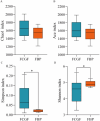Evaluating the potential of fermented bakery by-products as a replacement for corn gluten feed in cattle diets to suppress methanogenesis and alter rumen fermentation in growing Holstein bulls
- PMID: 40182280
- PMCID: PMC11965602
- DOI: 10.3389/fmicb.2025.1485688
Evaluating the potential of fermented bakery by-products as a replacement for corn gluten feed in cattle diets to suppress methanogenesis and alter rumen fermentation in growing Holstein bulls
Abstract
Both corn gluten feed and bakery by-products are important alternative concentrate feedstuffs for ruminants. Bakery by-products, which are rich in ether extract (EE) and starch, have the potential to be utilized as concentrate feedstuffs for ruminants, with a capacity to reduce ruminal methanogenesis. In the study, fermented corn gluten feed (FCG) and fermented bakery by-products (FBP) were mixed with other feedstuffs to formulate FCG and FBP diets, respectively. Twenty growing Holstein bulls, weighing 241 ± 10.5 kg, were randomly assigned to one of two dietary treatments: FCG or FBP diet. The aim was to investigate effects of replacing FCG with FBP feedstuff on nutrient digestibility, ruminal fermentation, ruminal microbiota, and methanogenesis. Results showed that the bulls feeding FBP diet had greater starch intake (p < 0.01) and digestibility (p = 0.04), EE intake (p < 0.01) and digestibility (p = 0.01), molar proportion of ruminal propionate (p < 0.01), while lower crude protein (CP) (p < 0.01) and neutral detergent fiber (NDF) digestibility (p = 0.01), ruminal dissolved methane concentration (p = 0.02), percentage of ruminal acetate (p < 0.01) and butyrate (p < 0.01), and the ratio of acetate to propionate (p < 0.01), in comparison with those feeding FCG diet. Further investigation on the bacterial community indicated that feeding the FBP diet had greater abundance of Succiniclasticum (p = 0.02), Megasphaera (p < 0.01), Lachnospiraceae_unclassified (p < 0.01) and Lachnospira (p < 0.01), while lower abundance of Christensenellaceae_R-7_group (p < 0.01), Ruminococcus (p < 0.01) and NK4A214_group (p = 0.01). The increases in EE and starch intakes after the substitution of FCG by FBP feedstuff alter fermentation rumen pathway from acetate to propionate production through enriching the propionate producers with net hydrogen incorporation, and reduced ruminal methanogenesis.
Keywords: bacteria; dissolved methane; fermented bakery by-products; nutrient digestibility; rumen fermentation.
Copyright © 2025 Pu, Zhang, Yang, Zhang, Wang, Li, Yang, Cai, Huo, Sun, Tan, Lin and Wang.
Conflict of interest statement
The authors declare that the research was conducted in the absence of any commercial or financial relationships that could be construed as a potential conflict of interest.
Figures



References
-
- AOAC (2005). Official methods of analysis. 18th Edn. Gaithersburg, MD: AOAC International.
-
- Bhatt R., Soren N. M., Tripathi M. K., Karim S. A. (2011). Effects of different levels of coconut oil supplementation on performance, digestibility, rumen fermentation and carcass traits of Malpura lambs. Anim. Feed Sci. Technol. 164, 29–37. doi: 10.1016/j.anifeedsci.2010.11.021 - DOI
LinkOut - more resources
Full Text Sources
Miscellaneous

